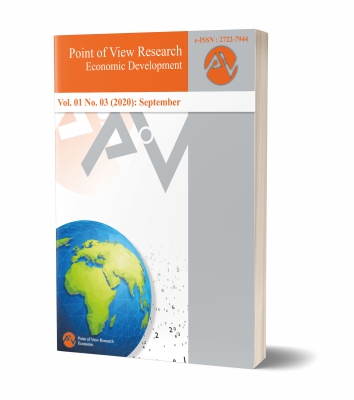The Role of Public Expenditure and Private Investment on Economic Growth in Makassar
Abstract
This study aims to determine the influence of government spending and private investment on Economic Growth in Makassar City. Descriptive data analysis methods and quantitative approaches. The data collected is secondary data using document studies obtained from the Makassar City Central Bureau of Statistics (BPS) and the One-Stop Integrated Services and Investment Agency (DPMPTSP) in Makassar City. This study uses multiple linear regression data analysis techniques and statistical tests. The results showed that Government Expenditure Variables positively and significantly affect economic growth in Makassar City. Private Investment Variables have a positive and significant impact on Economic Growth in Makassar City. Government Expenditure and Private Investment have a positive and significant effect on Economic Growth in Makassar City.
Downloads
References
Adelman, I., & Morris, C. T. (1973). Economic growth and social equity in developing countries. Stanford University Press.
Afroz, R., Muhibbullah, Md., & Morshed, M. N. (2020). Impact of Information and Communication Tech-nology on Economic Growth and Population Health in Malaysia. The Journal of Asian Finance, Eco-nomics and Business, 7(4), 155–162.
Arfah, A., Olilingo, F. Z., Syaifuddin, S., Dahliah, D., Nurmiati, N., & Putra, A. H. P. K. (2020). Econom-ics During Global Recession: Sharia-Economics as a Post COVID-19 Agenda. The Journal of Asian Fi-nance, Economics and Business, 7(11), 1077–1085.
Barata, A. (2019). Strengthening national economic growth and equitable income through sharia digital economy in Indonesia. Journal of Islamic Monetary Economics and Finance, 5(1), 145–168.
Bohlmann, H. R., Horridge, J. M., Inglesi-Lotz, R., Roos, E. L., & Stander, L. (2019). Regional employ-ment and economic growth effects of South Africa’s transition to low-carbon energy supply mix. En-ergy Policy, 128(July 2018), 830–837. https://doi.org/10.1016/j.enpol.2019.01.065
Burhan, N. A. S., Mohamad, M. R., Kurniawan, Y., & Sidek, A. H. (2014). National intelligence, basic human needs, and their effect on economic growth. Intelligence, 44, 103–111. https://doi.org/https://doi.org/10.1016/j.intell.2014.03.007
Devarajan, S., Swaroop, V., & Zou, H. (1996). The composition of public expenditure and economic growth. Journal of Monetary Economics, 37(2), 313–344.
Florek, I. (2012). Sustainable Tourism Development. Region Formation and Development Studies - Journal of Social Sciences, 157–166. https://doi.org/10.1007/3-540-25815-9_16
Habibi, F., Rahmati, M., & Karimi, A. (2018). Contribution of tourism to economic growth in Iran’s Prov-inces: GDM approach. Future Business Journal, 4(2), 261–271. https://doi.org/10.1016/j.fbj.2018.09.001
Ioan, D. (2014). Employment – Cause and Effect of the Economic Growth. Procedia Economics and Fi-nance, 8(14), 268–274. https://doi.org/10.1016/s2212-5671(14)00090-2
Kuznets, S. (1955). Economic growth and income inequality. The American Economic Review, 1–28.
Lee, J. W., & Xuan, Y. (2019). Effects of Technology and Innovation Management and Total Factor Productivity on the Economic Growth of China. The Journal of Asian Finance, Economics and Busi-ness, 6(2), 63–73.
Lingens, J. (2007). Unions, wage setting, and economic growth. Economic Modelling, 24(1), 167–188. https://doi.org/10.1016/j.econmod.2006.06.009
Liu, D., Xu, C., Yu, Y., Rong, K., & Zhang, J. (2019). Economic growth target, distortion of public ex-penditure and business cycle in China. China Economic Review, December 2018, 101373. https://doi.org/10.1016/j.chieco.2019.101373
Luong, T. T. H., Nguyen, T. M., & Nguyen, T. A. N. (2020). Rule of Law, Economic Growth and Shadow Economy in Transition Countries. The Journal of Asian Finance, Economics and Business, 7(4), 145–154.
Moutinho, R. (2017). Inside the ‘Black-Box of Innovation’: Translating R&D outlays into economic and employment growth. Journal of Engineering and Technology Management - JET-M, 45(August), 37–53. https://doi.org/10.1016/j.jengtecman.2017.06.002
Moutinho, R., Au-Yong-Oliveira, M., Coelho, A., & Manso, J. P. (2015). Beyond the “Innovation’s Black-Box”: Translating R&D outlays into employment and economic growth. Socio-Economic Planning Sciences, 50, 45–58. https://doi.org/10.1016/j.seps.2015.04.001
Radas, S. (2009). The antecedents of SME innovativeness in an emerging transition economy. Technovation, 29(6), 438–450. https://doi.org/10.1016/j.technovation.2008.12.002
Ranis, G., Stewart, F., & Ramirez, A. (2000). Economic growth and human development. World Develop-ment, 28(2), 197–219.
Roşoiu, I. (2015). The Impact of the Government Revenues and Expenditures on the Economic Growth. Procedia Economics and Finance, 32(15), 526–533. https://doi.org/10.1016/s2212-5671(15)01428-8
Sadiku, M., Ibraimi, A., & Sadiku, L. (2015). Econometric Estimation of the Relationship between Unem-ployment Rate and Economic Growth of FYR of Macedonia. Procedia Economics and Finance, 19(15), 69–81. https://doi.org/10.1016/s2212-5671(15)00009-x
Solow, R. M. (1956). A contribution to the theory of economic growth. Quarterly Journal of Economics. https://doi.org/10.2307/1884513
Sukirno, D. S., & Siengthai, S. (2011). Does participative decision-making affect lecturer performance in higher education? International Journal of Educational Management, 25(5), 494–508.
Szkorupová, Z. (2014). A Causal Relationship between Foreign Direct Investment, Economic Growth and Export for Slovakia. Procedia Economics and Finance, 15, 123–128. https://doi.org/10.1016/S2212-5671(14)00458-4
Taylor, L., Rezai, A., & Foley, D. K. (2016). An integrated approach to climate change, income distribution, employment, and economic growth. Ecological Economics, 121, 196–205. https://doi.org/10.1016/j.ecolecon.2015.05.015
Vandernoot, J., & van Hove, C. (2014). Disparities between development regions and district development committees in Nepal. International Advances in Economic Research, 20(3), 353–355.
Wu, X., Wang, Z., Gao, G., Guo, J., & Xue, P. (2020). Disaster probability, optimal government expendi-ture for disaster prevention and mitigation, and expected economic growth. Science of The Total Envi-ronment, 709, 135888. https://doi.org/10.1016/j.scitotenv.2019.135888
Zagler, M. (2005). Wage pacts and economic growth. Journal of Economic Studies, 32(5), 420–434. https://doi.org/10.1108/01443580510622405
Zaidi, S., & Saidi, K. (2018). Environmental pollution, health expenditure and economic growth in the Sub-Saharan Africa countries: Panel ARDL approach. Sustainable Cities and Society, 41(April), 833–840. https://doi.org/10.1016/j.scs.2018.04.034
Copyright (c) 2021 D. Dahliah

This work is licensed under a Creative Commons Attribution 4.0 International License.



















